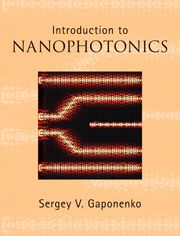Book contents
- Frontmatter
- Contents
- Preface
- Notations and acronyms
- 1 Introduction
- Part I Electrons and electromagnetic waves in nanostructures
- 2 Basic properties of electromagnetic waves and quantum particles
- 3 Wave optics versus wave mechanics I
- 4 Electrons in periodic structures and quantum confinement effects
- 5 Semiconductor nanocrystals (quantum dots)
- 6 Nanoplasmonics I: metal nanoparticles
- 7 Light in periodic structures: photonic crystals
- 8 Light in non-periodic structures
- 9 Photonic circuitry
- 10 Tunneling of light
- 11 Nanoplasmonics II: metal–dielectric nanostructures
- 12 Wave optics versus wave mechanics II
- Part II Light–matter interaction in nanostructures
- Author index
- Subject index
11 - Nanoplasmonics II: metal–dielectric nanostructures
from Part I - Electrons and electromagnetic waves in nanostructures
Published online by Cambridge University Press: 05 June 2012
- Frontmatter
- Contents
- Preface
- Notations and acronyms
- 1 Introduction
- Part I Electrons and electromagnetic waves in nanostructures
- 2 Basic properties of electromagnetic waves and quantum particles
- 3 Wave optics versus wave mechanics I
- 4 Electrons in periodic structures and quantum confinement effects
- 5 Semiconductor nanocrystals (quantum dots)
- 6 Nanoplasmonics I: metal nanoparticles
- 7 Light in periodic structures: photonic crystals
- 8 Light in non-periodic structures
- 9 Photonic circuitry
- 10 Tunneling of light
- 11 Nanoplasmonics II: metal–dielectric nanostructures
- 12 Wave optics versus wave mechanics II
- Part II Light–matter interaction in nanostructures
- Author index
- Subject index
Summary
Nanoplasmonics is a modern extensively expanding field of optics. It basically develops from the rather old field of metal optics including properties of dielectrics with subwavelength nanometer-size metal inclusions. For this reason, reading of Chapter 6 is strongly recommended prior to proceeding to the content of this chapter.
This chapter is organized as follows. First, local electromagnetic field enhancement of near metal singularities in a dielectric environment is considered. Further, multiple scattering phenomena are discussed including extraordinary transmission of a hole array in a metal film. Then, spatially organized metal–dielectric structures are discussed and for that section to be well understood, Chapter 7 will be helpful as will Chapter 10, where the tunneling of light in metal structures has been treated. Possible effects of metal nanoparticles on laser action and gain media properties are discussed as well. A separate section deals with general properties of negative refraction materials. This is included in this chapter since experimental realization of negative refraction in optics is based on periodic metal–dielectric metamaterials with specific subwavelength-scale architecture. Negative-refraction optics (and electrodynamics) emerged just a few years ago and the introductory style of this issue in the present chapter is believed will assist the interested reader in further self-learning through browsing in the many original papers on that matter.
As with all previous chapters in this book, the consideration in this chapter is organized rather like a guide into the field with emphasized physical phenomena than instructions for calculations and for fabrication of nanoplasmonic structures.
- Type
- Chapter
- Information
- Introduction to Nanophotonics , pp. 336 - 367Publisher: Cambridge University PressPrint publication year: 2010



